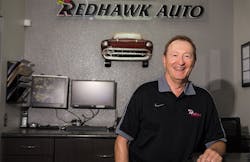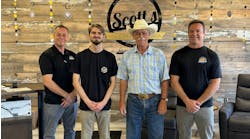It’s never too late to start something new. Just ask Tom Grady, who purchased Redhawk Auto Service 13 years ago after roughly 30 years in the larger automotive industry.
After years working for manufacturers and managing dealerships, Grady was ready for a new challenge—and he found it in the purchase of the middling Redhawk Auto in 2005.
To say the least, it was a trial by fire. Prior to being purchased by Grady, Redhawk staff performed minimal repairs, instead focusing on quick oil changes and tire rotations. It was “very challenging” for Grady to get a handle on the shop’s overall performance without KPIs. As a former dealer manager, Grady had access to KPIs on “almost every facet of the operation;” now, he was tasked with running a shop without those key statistics.
Grady had inherited lower-level technicians (B- and C-level) and service advisors, outdated equipment and few successful marketing tactics.
Regardless, Grady was aware of the challenges, and he leveraged his background in four simple ways to increase sales by more than 400 percent from $25,000 per month when he first acquired the 2,000-square-foot shop to a current annual total of $1.5 million.
1) Leverage Previous Experience.
Grady’s decades of experience have him filling myriad roles. He started at Ford after receiving his MBA in international business. His time in their management development program was “fantastic” but “very corporate.” The work was challenging and required great discipline, but he “got good exposure to all aspects of the business,” especially financial analysis.
A strong entrepreneurial spirit led Grady to leave Ford to manage a dealership in New York for two years, where he learned the marketing side of the business. Later, he managed a Nissan dealership in Orange County after a move to California and opened a car wash.
After purchasing Redhawk, although he had to learn about the day-to-day operations of a repair shop on the fly, Grady brought many of his successful practices with him. In his time with both Ford and Nissan, he “got to work with dozens and dozens of dealers, both good and bad.” He saw exactly why dealers succeeded and failed in great detail.
In addition to learning about personnel development and financial analysis, Grady saw that “[dealers] who did well were honest, and had integrity and great marketing,” while those who failed were dishonest, had poor hiring practices, and didn’t advertise. He took note of each of these specific things and applied them to Redhawk.
2) Hire Better People.
Now, Redhawk Auto has some of the most proficient techs and advisors in the area, including three ASE master techs. This turnaround stemmed from Grady’s belief that everything comes from “having the best people.”
As employees naturally left, Grady sought the best new employees in the area. These hires were discovered through many referrals, from previous employees and vendors, and through ads on Craigslist. Grady has developed a three-stage interview process that covers every base. There is an introductory phone interview, a more personal interview over a meal, often with Grady’s wife present, and finally, a formal interview with management.
Once an employee was hired, they were strongly encouraged and even financially incentivized to achieve their ASE certifications. Technicians also went through training with the Automotive Training Institute (ATI), a coaching and consultation company based in Maryland.
Employees are also motivated by higher paychecks. While lower-level technicians are paid a flat salary, service advisors and managers are paid on performance, depending on how much gross profit an individual generates. This “reinforces productivity,” Grady says, since “salaries promote complacency.”
The shop’s equipment needed a boost as well. New lifts, new diagnostic equipment, and specialty tools were purchased. They have gone from a system of six repair bays with only two in-ground lifts to a much more substantial six-life setup. Redhawk has even added a completely new customer area with three kiosks and four stand-alone service stations.
“We have been procuring special tools and diagnostic equipment since the beginning to remain state of the art,” says Grady.
The shop has also boosted its digital service abilities with technology from Bolt On, a shop management software company. Employees always have input on these decisions, given that they are “closest to that system.”
“We needed all the new and latest equipment,” Grady says.
Grady and the team at Redhawk are able to manage all of their employees and general expansion with the reincorporation of KPIs. They keep track of things like sales, gross profit, average repair orders, technician productivity, expense percentage, and more through their ATI web portal. The shop utilizes QuickBooks accounting software to verify and validate its KPI data and to make informed changes if necessary.
Paying attention to KPIs has allowed the shop to improve in even more ways. The ARO at the start was only $148; it has now nearly tripled to a total of $425.
3) Implement Solid Marketing.
Marketing also became an essential part of Redhawk’s new approach. This was primarily done by increasing the shop’s Internet presence. Grady utilized CRM (customer relationship management) software to help manage online interactions and reviews. SEO (search engine optimization) is also a key part of how new customers are reached.
Redhawk encourages customers to leave reviews by utilizing the LocalSearch tool from Mitchell 1, a popular auto repair software. LocalSearch directly sends a text message to a customer and provides them easy access to sites like Google and Yelp, where they can leave a review. Currently, Redhawk has over 1,300 reviews on SureCritic, an auto review site, with 85 percent giving a five-star rating.
Mitchell 1 also provides a (CRM) software. This is used to manage the Redhawk website and its SEO, and Google AdWords.
Programs like the ones from Mitchell 1 and Mudlick Mail, a direct mail service, have helped Grady to saturate the market and continue to grow their customer base. This proved to be an essential way of generating web traffic, both when Grady first started and now.
Emphasizing that Redhawk is family owned has been a key angle of the shop’s online marketing. There are four tire chains with locations surrounding Redhawk, providing the shop with a profitable contrast.
4) Build Relationships with Customers.
“The customer comes first” is a fairly common mantra used by a great deal of business, Redhawk Auto included.
“To become a successful business, it is paramount to build long-term customer relationships through a culture of credibility,” he says.
If something doesn’t increase the customer’s trust, Grady won’t do it. Potential customers need to be able to trust that their vehicle will be repaired and maintained properly.
In order to gain this type of relationship with customers, Grady and his employees must be honest.
“To attain this level of trust, we must have the best techs we can afford and the most honest, knowledgeable, and friendly service advisors,” he says.
What sets them apart is how they go beyond what is normally just marketing and sloganeering. Grady takes this mindset and implements in the community at large.
In the past, Grady was a Chamber of Commerce chairman, and his wife was a PTA president (1993)and Volunteer of the Year (1990). (They are also members of the West Coast ATI 20 Group, which facilitates service projects with the military and donations to the Army Rangers. Redhawk Auto also partners with the Marines to be a collection center for Toys for Tots every year.
The Gradys also express their giving spirit on a larger scale. To honor their daughter’s memory, who passed from asthma-related complications, and to extend the reach of their generosity, they give away a scholarship to a member of her sorority at the University of Arizona pursuing careers in nursing, social work, or psychology. This yearly scholarship acts as a way of paying it forward in their daughter’s honor. Additionally, they donate to St. Jude’s in her name.
Community involvement lends credibility to the shop in a significant way. The customers’ positive feeling towards Redhawk’s engagement with the community directly transfers to a feeling of caring about their vehicle.
“Customers feel comfortable knowing that the business ownership is involved in local activities and [that it] cares about the community,” says Grady.
SHOP STATS: Redhawk Auto Service Location: Temecula, Calif. Operator: Tom and Donna Grady Average Monthly Car Count: 270 Staff Size: 10 Shop Size: 2,000 sq ft Annual Revenue: $1.5 million



